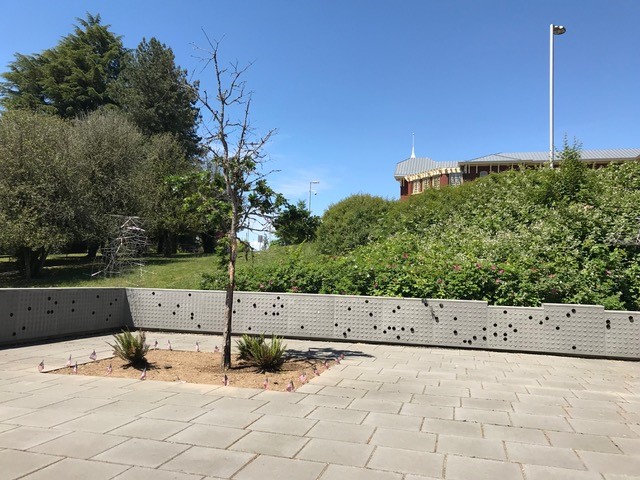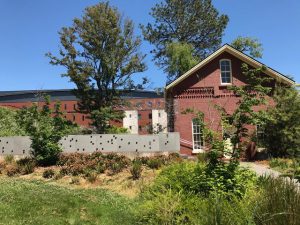
If you do family history long and broadly enough (searching out great-great-aunts and fifth cousins, as well as your direct ancestors), you’re sure to find them: family members whose census or burial records indicate that they were living in a state hospital or similar institution.
A couple of weeks ago, my husband and I visited the Oregon State Hospital’s museum … and also their memorial garden, which houses the unclaimed ashes of thousands of people who died at various state institutions. The ashes had been stored for about a decade in underground vaults, but after water seepage was discovered, the copper canisters were removed and consigned to shelves in a storage room. Then a group of legislators touring the hospital brought their existence to light in 2004, and that discovery helped spark change for the hospital’s residents, living and dead.
Even the mid-twentieth-century buildings (including the one where Ken Kesey’s One Flew Over the Cuckoo’s Nest was filmed in 1975) have been demolished…
The oldest part of the hospital, built in the late nineteenth century, now no longer houses residents but has been preserved for the museum and offices. Even the mid-twentieth-century buildings (including the one where Ken Kesey’s One Flew Over the Cuckoo’s Nest was filmed in 1975) have been demolished, and residents now live in all new facilities.

But what to do with those thousands of unclaimed remains? Two things happened: A memorial was designed to respectfully house them and display the fascinating (now empty) copper canisters, and the legislature passed a bill allowing their names to be published so that family members might find them. Devoted volunteers then began researching their life histories and making the information available online. One by one, remains have been departing and going home.
Almost two years ago, the case of a Civil War veteran who had been interred in this memorial gained a degree of publicity … even notoriety. Pvt. Jewett Williams had been a member of the 20th Maine Volunteer Infantry, and saw Lee’s surrender at Appomattox Courthouse. Eventually he made his way to Oregon, where he died in 1922, three months after arriving with dementia at the state hospital.

A Maine historian discovered his name and details online, and arrangements were made for his remains to be taken by Patriot Guard Riders across the country – with a stop in Appomattox – to Maine for interment at Togus National Cemetery. A local group of Civil War re-enactors were honored to take part in memorial services for Pvt. Williams as he set out on his journey … not least because they portray the 20th Maine Volunteer Infantry. He was truly a brother soldier!
Things got a little dicey by the time Pvt. Williams’s remains actually arrived in Maine; by that time distant cousins had learned about him and wanted to have his remains buried with his parents in his hometown of Hodgdon. Not all of the folks who’d arranged for the journey agreed, and there were some hard feelings.
I remembering hearing about all this on the genealogy podcast Extreme Genes, and it sounded very interesting, but not in a personal way. Then I discovered that the brother-in-law of my maternal grandfather’s aunt was enumerated in the 1900 census at the Oregon State Insane Asylum, as it was then called. I presume (but don’t know for certain) that his death four years later at the age of 33 occurred at the institution.
Wiley Hubbard was the youngest son of William Cannon Hubbard, a former Marion County Commissioner whose family settled in the Willamette Valley a decade before Oregon became a state in 1859. According to an 1893 city directory, he had been living with his family just a few blocks from my current home! If Wiley died at the state hospital and had been unclaimed by his family, he would have been buried in their cemetery … and no one knows what happened to those remains after they were disinterred in 1913.
Thankfully, Wiley was spared this fate, and lies buried in the family plot at Claggett Cemetery, north of Salem.
Very interesting story. I have a great uncle that ended up in Oregon after years of almost no contact with family. As far as we know he had no wife or children. I tried for a long time to find him and it turns out he is in a Veteran’s Cemetery in Oregon. Before I found where he was I had a thought to bring him home to MA with the rest of his family, he was the last of the siblings. But I think he made his own choice long ago. Thankfully he wasn’t in a state hospital.
Private Williams was in the famed 20th Maine which made an heroic stand at Little Round Top on July 2, 1863, the second day of the Battle of Gettysburg, under the command of Col. Joshua Chamberlain who was awarded the Medal of Honor for this stand. But private Williams did not join this regiment until October 1, 1864. Williams was with the regiment when it was mustered out in Washington, D. C., in July, 1865 so he was probably present when then Brigade Commander Joshua Chamberlin was selected by General Grant to accept the physical surrender and stacking of arms and battle standards of Lee’s army at Appomattox Courthouse on April 12, 1865. Neither Grant nor Lee attended the physical surrender. Then Brevet Major General Chamberlin ordered Union Troops present, including the 20th Maine, to perform what he described as a marching salute to the surrendering Confederate troops and the surrendering troops and their commander reciprocated.
Thanks for the Civil War expertise! I had not known that the two tops generals were not actually present at the surrender, though I had figured that Pvt. Williams was not part of the 20th Maine during some of their storied battles, since he joined up comparatively late in the war.
I recently obtained the medical records for an ancestor that died in the MN “Hospital for the Insane” in 1913. The records indicate he was suffering from effects of a previous stroke, had dementia, and some odd behavior. Cause of death is listed as “chronic interstitial nephritis” although there is no discussion of this in the records. The term “insane” must have been used differently one hundred years ago.
I believe that those suffering from dementia often ended up in state hospitals, especially if they had no family or if their family was not able to care for them. Since those patients would have been considered not mentally competent, they would have fallen under the umbrella of insanity. Although people suffering from dementia are now generally in private care facilities if not at home, I believe there are still geriatric psych wards today.
I’m trying to find out what happened to my 3rd great grandmother, Mary Eliza Marshall. Her father raped her and committed incest against her and her sister.
She and her sister were both supposed to have had a child due to the incest…and I believe that she is my ancestor.
A distant cousin had interviewed a nephew…said that she either had a nervous breakdown, or went insane…..and spent the rest of her life in a mental institution.
There was a court trial and conviction in 1828 in Chardon, Geauga, Ohio. Amos Marshall was indentured to Albert Hoyt in 1830 at the age of 3. I am looking for suggestions for finding out what /where Mary Eliza Marshall went, and when she died.
Any suggestions or assistance is greatly appreciated. I have not been able to find any asylums in the 1828-1835 era in Ohio.
Karen
I found this interesting article about the earliest state hospital in Ohio, which opened in the late 1830s. It states that prior to its opening, patients often were in other hospitals, or even prisons. The comments are also interesting, and one of the last has contact information for a man who is working on the history of the state hospital in Columbus. Perhaps he might have some leads for you.
https://maskofreason.wordpress.com/the-book-of-mysteries/eerie-ohio/lunatic-asylum-of-ohio/
Thank you Pamela…an interesting , sad and horrifying article. I believe that people who have mental illness make us feel uneasy. I have a brother who has paranoid schizophrenia.
He can be quite lucid for a while, and then be in another world .
Thank you for sharing this article…maybe I will find Mary Eliza Marshall some day.
This intrigued me, as I just finished researching a great-aunt, Sarah Vining, who spent 60 years in the Kansas Asylum for the Insane.
Then I got to the end of your post and saw the mention of the Claggett family plot. I have Claggetts on my tree but they settled in Kansas in the mid-1800s. Maybe we are distantly related.
The Claggetts were early settlers of the area just north of Salem, Oregon, and Claggett Creek runs very near Claggett Cemetery, which is evidently a rather small one. I’ve never visited, but I think it’s about time!
Pamela, one of my great grandmothers died at the Worcester State Hospital in 1892 after being there for about a decade. I’ve tried in the past to get information but received no reply. Do you know if the situation has changed? Is it possible to get information on someone who was a patient there? Thanks for any help.
Gosh, I’m afraid that I’m at a loss. I’m just a little ol’ amateur out here in Oregon, literally typing this in my PJs! I did look up the Worcester State Hospital and saw that they’ve undergone a transition similar to the Oregon State Hospital: only the most impressive old buildings are left, and new ones opened in 2012. It was interesting to me to see that both institutions’s old buildings were designed on the Kirkbride Plan, based on the theories of a Pennsylvania doctor named Thomas S. Kirkbride.
I’m not sure how long ago you contacted them, but perhaps if they were in the midst of their big transition, it was a hard time to respond to inquiries about patients of long ago. It might be a more settled time now, and perhaps you’ll get a response if you write again. On the other hand, I’ve written to churches for baptismal and marriage records and also never received replies. Sadly it happens; it can be hard for staff who are already overworked caring for the needs of the living to find time to do research on the dead.
From one “Quacker” to another, try here, and scroll down under the “City” header.
http://libguides.worcester.edu/archives/Resources
I’m glad to have this link to my Great Uncle, I learned from genealogy records that he was committed to this facility and sure enough I found his name after searching the list from the website, which confirmed that he was there b.1899 d.1966. I would have been 15 years old and had no idea of him. Thank you for this connection. It’s a tragic end.
I’m so sorry that your great uncle died at the hospital, and also that you never even knew he existed during the time you both were alive. On the other hand, I’m thankful that the hospital has made records available online so family members can get a sense of connection and closure.
A few years ago, I was contacted through Ancestry by a woman who had made it her mission to find the family of these inpatients who ashes had been left at the hospital. Only a blood relative can claim the ashes. My ancestor who died there in 1936 was Horace Gunderson, the brother of my great-grandfather Carl Gunderson. My great grandfather never knew that his brother had been admitted to the Oregon State Hospital because he died before Horace was admitted. Knowing how strongly my grandfather felt about family, I’m certain he did not know where his uncle was. I was able to claim the ashes. We still had a plot in our family’s section of the Pine Bluff Cemetery in Vermillion, South Dakota. The family had lived in Vermillion for several generations and Horace was born and raised there. In Sept 2016, a few family members went to Vermillion and had a small ceremony there to bury his ashes with other members of the family. We felt it important to bring him home.
That sounds like a lovely thing for your family to have done. I’m glad you were contacted so that you could have the opportunity.
Does anyone know if Dannemora Asylum in northern New York has any records of deaths available for back in the 1940-1960 era? My cousin had a great great uncle who evidently died there some time after the 1930 US Census.
I found information about the asylum, but no records about deaths or inmates when I was researching a few years ago.